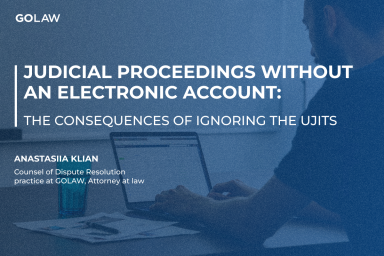Bankruptcy in Ukraine: key features
Today Ukraine continues to undergo the reform of the bankruptcy system, aimed at improving the business environment and increasing the investment attractiveness of the country. The bankruptcy proceeding seems like a major challenge for a creditor, as it is usually a tedious and time-consuming process. In order to speed it up and make it more efficient, the Bankruptcy Code of Ukraine was adopted in 2019 (hereinafter — the “Code”). One of the objectives of the Code is to satisfy creditors’ claims. But it also aims to protect debtors’ rights. The main features of a bankruptcy proceeding in Ukraine are the following.
Bankruptcy of a legal entity
The bankruptcy of a legal entity may be initiated both by the creditor and by the debtor of the legal entity itself. However, creditors may join their claims and file one joint application with the court.
Previously, only a creditor whose undisputed claims amounted at least three hundred times the minimum wage could file an application to initiate a bankruptcy case. This put creditors with smaller claims at a disadvantage.
Today this limitation has been lifted. The mere existence of a monetary claim against the debtor is sufficient to make an application. Furthermore, the creditor does not need to enclose any evidence of recovery of the amount of debt from the debtor.
On application, however, the creditor incurs expenses such as a court fee and an advance payment to the bankruptcy receiver.
When a bankruptcy case starts, the relevant information is published on the website of the Ukrainian judiciary, which is open and free of charge. This gives all creditors the opportunity to learn about the relevant case and file their claims within 30 days of its publication.
At the same time, a moratorium on creditor claims is imposed. This means that the debtor’s monetary liabilities, even those that were due before the moratorium, are suspended.
It is worth noting that bankruptcy proceeding for a legal entity cannot be suspended, which has an undeniable impact on its duration. The Code provides a limited list of court judgements that may be appealed in cassation. It evidently has a positive impact on the speed of proceedings. Thus, “bad faith” debtors are deprived of the possibility to unreasonably delay the process by filing unreasonable complaints.
Creditors’ rights protection in bankruptcy proceeding of a legal entity
The Code provides for a number of legal mechanisms to enable creditors to actively participate in a bankruptcy proceeding.
After the opening of the proceedings, the court may, at the request of the creditor, take steps to secure its claims, such as prohibiting the debtor from performing transactions without the consent of the bankruptcy receiver; and obliging the debtor to transfer securities and property to third parties for safekeeping.
A precise auction procedure in the electronic trading system ensures transparency and reduces corruption risks. In order to satisfy as many creditors’ claims as possible, the Code envisages that the first auction is to be held without the option of initial price reduction. Subsequent auction may be held with the option of initial price reduction only by consent of the secured creditor or committee of creditors.
Unfortunately, the procedure of administration of property evidences the cases where the debtor fails to take measures to preserve its property, obstructs the actions of the administrator of the property, infringes rights and legal interests of the creditor. In such a case, the creditor has the right to request the court to terminate the authority of the director or management body of the debtor and to entrust the execution of its duties to the administrator of the property.
The creditor may also initiate the removal of the bankruptcy receiver if the latter fails to perform or improperly performs the duties or abuses its rights. In addition, once the committee of creditors submits an application, the court may remove the bankruptcy receiver regardless of grounds.
In addition to the above options, in bankruptcy proceedings a creditor may apply to invalidate a transaction in which the debtor, for example, alienated the property free of charge or donated it at prices above market value. This applies not only to the debtor’s transactions after the commencement of the bankruptcy proceeding but also the debtor’s transactions during the three years preceding it.
Insolvency of an individual
The brand new legal provisions have been introduced to regulate the restoration of the individual’s solvency. This option allows a debtor in distress to initiate its insolvency proceedings by itself. The creditor is not permitted to file such an application.
The advantage of this procedure is that after the case proceeding is closed, the court decides to release the individual from the debts. However, this does not apply to compensation for injury, damage to the health of life, alimony and other claims that are linked to the individual.
In spite of the positive developments, it’s important to remember that the following limitations and consequences are imposed on the individual who declares bankruptcy:
- absence of the right to initiate another bankruptcy proceeding within five years;
- the need to notify creditors of bankruptcy in writing within the next five years;
- loss of an impeccable business reputation for the next three years.
Thus, Ukraine’s bankruptcy legislation is aimed not only at speeding up procedures in bankruptcy cases, but also at increasing the effectiveness of protective mechanisms for business in such cases. The Code provides for a number of measures by which creditors can control bankruptcy proceedings. These innovations have brought this procedure to a new level of quality and transparency.

Kateryna Manoylenko
Partner, Head of Litigation and Dispute Resolution practice, Attorney at law
- Contacts
- 31/33 Kniaziv Ostrozkykh St, Zorianyi Business Center, Kyiv, Ukraine, 01010
- k.manoylenko@golaw.ua
- +380 44 581 1220
- Recognitions
- The Legal 500 EMEA 2024
- Who's Who Legal 2022 - 2024

Natalia Matviichuk
Senior Associate, Attorney at law
- Contacts
- 31/33 Kniaziv Ostrozkykh St, Zorianyi Business Center, Kyiv, Ukraine, 01010
- n.matviychuk@golaw.ua
- +38 044 581 1220
Sign up to be aware
New achievements are inspired by information. GO further, don’t miss out GOLAW news and legal alerts
Our expertise
-
- Antitrust and Competition
- Banking and Finance
- Compliance, Corporate Governance and Risk Management
- Corporate and M&A
- Criminal and White Collar Defence
- Defense in Anti-corruption procedures and regulations
- Labor and Employment
- Natural Resources and Environment
- Government Relations (GR)
- Insolvency and Corporate Recovery
- Intellectual property
- International trade
- Legal support of business and private Сlients in Germany
- Litigation and dispute resolution
- Private clients
- Real Estate and Construction
- Energy and Natural Resources
- Restructuring, Claims and Recoveries
- Martial Law
- Tax and Customs
-
- Agribusiness
- Aviation
- Chemical industry
- Engineering, Construction and Building Materials
- Natural Resources and Environment
- Financial institutions
- IT and AI
- Industry and manufacturing
- Healthcare industries, Life sciences and Pharmaceuticals
- Media, Entertainment, Sports and Gambling
- Retail, FMCG and E-Commerce
- Transport and Logistics
We use cookies to improve performance of our website and your user experience.
Cookies policy
Cookies settings







